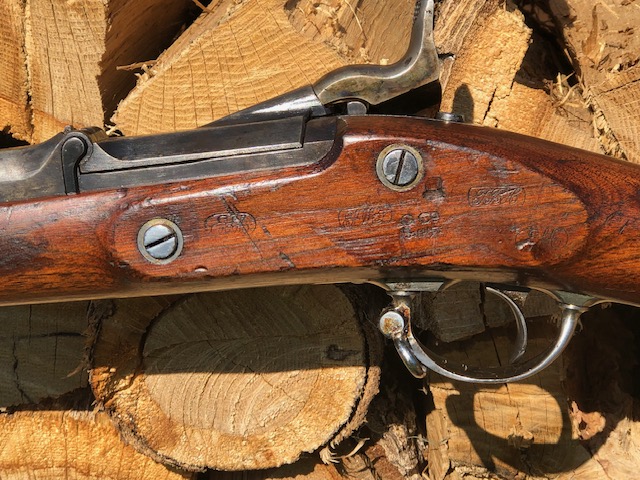To me, one of my favorite parts of the study and collecting of these arms is finding a particularly nice piece coming out of an old collection or some other location, the so called, "attic find". I recently acquired a nice M1868 rifle that looks like it hasn't changed much since it was greased up and packed away circa 1876. It still had smears of ordnance grease on it, and clumps of it in protected places. The bright parts were still bright, and the breech and breech block were still mostly the dark oil quenched smoke black color. The hammer and lock plate still had a large amount of color case hardening showing as well. All the cartouches are present and best of all, it has unit marks of "G Co 13 INF", on the stock flat on the left side between the cartouches. Ordnance records show that G Co., 13th Infantry received their M1868s in first quarter, 1871, while at Ft. Bridger, WY. They turned them back in shortly after as they were one of the companies that received the various 1871 experimental rifle types. About a year later, they turned in their experimentals and were again issued the M1868 trapdoors. They then were sent to Ft. Fred Steele, WY to guard railroad workers, and later to Camp Robinson, (Brown, Auger-all names for the same post) near the Shoshone Reservation to protect the Shoshone from attacks from the Sioux. They kept their M1868s until the final quarter of 1874 or first quarter 1875, when they received their new , .45 rifles and were sent to New Orleans for Reconstruction duty.
I had to replace the broken extractor spring and pin in this rifle. Interestingly, when I tore down this rifle, I found the ordnance grease on the bottom surfaces of all the metal, and the metal still pretty much pristine. As an aside, when I dismantled the block to gain access to the broken extractor parts, all I found in the extractor space was about a quarter inch of the extractor spring. The balance of the spring along with the entire extractor pin was totally missing. Of course I am assuming that it was an ordnance person that worked on it, but regardless of who did it, why did they disassemble the rifle far enough to gain access to the extractor parts, remove part of them (leave the small part of the broken spring), and then reassemble without fixing the extractor. My only thoughts on this was to not waste new parts on a now obsolete weapon, but the counter to that is that these rifles were kept around for issue to auxiliary personnel in the field, so should have been kept in good order. Oh well, another one of "those" questions we'll never know the answer to.


- IMG_3685.jpg (171.97 KiB) Viewed 5487 times

- IMG_3689.jpg (170.69 KiB) Viewed 5487 times
